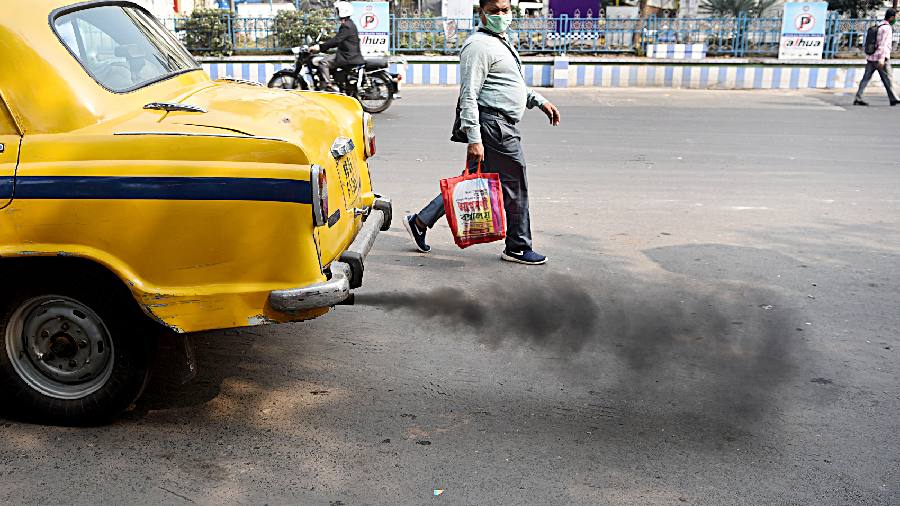Senior government officials and independent experts have raised questions about a recent ministry of environment, forest and climate change (MoEFCC) report uniformly benchmarking 46 bigger and smaller cities in air pollution control performance for 2023-24.
The report, Swachh Vayu Survekshan 2024 (Clean Air Study 2024), has ranked Kolkata 41st among 46 cities in the list, just above Chennai in terms of air pollution control performance among mega metropolises. The report has ranked cities based on their activities approved under the city action plan earmarked within the National Clean Air Programme (NCAP).
The trend is similar among the six major metropolises – Delhi, Mumbai, Kolkata, Hyderabad, Bangalore and Chennai – despite the cities collectively receiving around Rs 3,200 crores to control air pollution.
Kolkata, which has received Rs 846.25 crores since 2018-19, could spend nearly 80 per cent of the sanctioned amount. The city recorded a nearly 25 per cent reduction in the annual average of PM 10, the benchmark pollutant, during the period but the pollutant level of 2023-24 — 94 microgram per cubic metre of air — was still more than 50 per cent higher than the national permissible limit of 60 micrograms.
In a list that included 46 cities with a population of more than a million, New Delhi was found to be the best among major metros at 11th position, Bengaluru at 28th position and Mumbai at 32th. Kolkata got the 41st position, while Chennai was at number 45. Howrah was a shade better at 44.
Kalyan Rudra, chairman of West Bengal Pollution Control Board, pointed out that major cities face heightened challenges, and questioned the practice of fixing the same ranking yardstick for all the cities despite significant differences between them in context to scale, complexity, and exposure. “For example, Kolkata, close to the southern edge of the Indo Gangetic plain, receives transborder air pollution. How can the same level in parameters be fixed for it compared to cities which generate air pollution,” Rudra pointed out, stating that he has recently raised the issue in a World Bank meeting on air pollution where Union government officials were present.
Rudra, however, admitted that Kolkata needs to do away with the highly polluting diesel-driven vehicles to reduce air pollution. He opined that PM2.5 should be emphasised more as it is more toxic, while currently PM10 is considered as the improvement indicator.
Abhijit Chatterjee, an air pollution expert with the Bose Institute and adviser to National Clean Air Programme, said “the major sources of PM10 over a city needs to be identified and then the weightage should be set. The distribution of weightage should be based on the city specific and not generalised.”
Eight parameters considered
“All 130 cities covered under NCAP are assessed based on information submitted under the ranking framework by cities / ULBs (urban local bodies) on PRANA (Portal for Regulation of Air Pollution in Non-Attainment Cities),” reads the report. PRANA is the dashboard to capture progress under the NCAP programme.
The report further says that “assessment is done every year and cities are ranked based on the assessment of performance for the period (financial year i.e., 1st April to 31st March) of the preceding financial year. Specific weightage has been assigned for taking control measures in 8 identified sectors”.
Biomass and municipal solid waste burning, road dust, vehicular emission and emission from industries are all being given equal weightage of 20 per cent marks each, while dust from construction and demolition waste has been assigned 5 per cent, improvement in PM10 concentrations 2.5 per cent and an equal 2.5 per cent for IEC activities and public awareness. Controlling of other emissions has been given 10 per cent.
While major cities slide; Surat in Gujarat is the table-topper among cities with one-million-plus population with a score of 194 followed by Jabalpur, Madhya Pradesh, and Agra, Uttar Pradesh.
“These cities are being awarded for their significant improvements in air quality, achieved through the adoption of various best practices aimed at mitigating air pollution,” proclaims the report. It identified few key activities which made the difference like end-to-end paving on roads, promoting mechanical sweeping, bioremediation of legacy waste, construction and demolition waste, solid waste management, development of the reclaimed land of dumpsite, greenbelt development, intelligent traffic management system and Miyawaki forestation.
The report further says that assessment has been done based on submission of a self-assessment report along with supporting documents submitted by urban local bodies.
The reports and documents are then subsequently vetted by respective air quality monitoring committees, chaired by respective environment secretaries in environment and finally examined and evaluated by Central Pollution Control Board (CPCB) for ranking
Cloud over ranking
Among the major cities in the country, Delhi did the best with a score of 181 at the 11th national ranking, while Hyderabad got the 25th position (163.3), Mumbai 28th (159), Bangalore 32nd (155.1), Kolkata 41st (137.8) and Chennai lowest among the metro cities at the 45th position with 101.3 score.
The PRANA website shows out of Rs 11,211 crores so far released, the six mentioned major cities got Rs 3,285 crores, nearly 30 per cent, but hardly showed any improvement on ground in air pollution control through utilising just over 60 per cent of the allotted money on average.
“The multi-sector action needs massive scaling up in cities like Kolkata to reduce air pollution. But the ranking, which is based on self-reported data from cities, must be transparent and accessible to help validate what is working, not working and the magnitude of change on ground in cities,” said Anumita Roychowdhury, air pollution expert and executive director, research and advocacy, Centre for Science and Environment (CSE), India.

